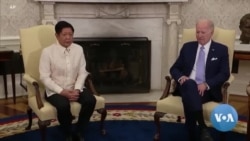Philippines’ President Ferdinand Marcos Jr. visits the White House.
Welcome to VOA Asia Weekly. I'm Chris Casquejo in Washington. That story is just ahead, but first, making headlines:
Myanmar's junta pardoned more than 2,000 political prisoners to mark a Buddhist holiday on Wednesday. The military has arrested thousands of protesters and activists since seizing power in February 2021 from the elected government of Aung San Suu Kyi’s National League for Democracy Party. Prisoner releases appear to be efforts by the hard-line military government to soften its image as a major human rights abuser.
Japan and South Korea held their first bilateral finance leaders' meeting in seven years on Tuesday. The meeting of finance ministers comes ahead of Japanese Prime Minister Fumio Kishida's planned visit to South Korea next week for talks with President Yoon Suk Yeol. Regular annual dialogue between the two countries' finance ministers had been suspended since 2016 due to disputes over wartime history.
Reporters Without Borders has just released its World Press Freedom Index for 2023. It evaluated 180 countries in 2022 and found that the press freedom environment in 70 percent of them was “problematic.” East Asia has some of the worst scores on the index. Vietnam ranked 178 on the list, China 179, and North Korea 180.
One of Thailand's leading prime ministerial candidates, Paetongtarn Shinawatra, told reporters on Wednesday she will be back on the campaign trail next week, just days after giving birth to her second child. Shinawatra expects her party to win this month’s elections.
Philippine President Ferdinand Marcos Jr. visited the White House Monday at a time of tension in the Indo-Pacific region. President Joe Biden said the U.S. commitment to the archipelago is "ironclad" amid enhanced military cooperation. The Philippines recently granted the U.S. access to four more military bases. VOA’s Anita Powell reports from the White House.
A meeting more than a decade in the making. The last time a Philippine president graced the White House was in 2012. Much has changed since then — and not just the men in charge. On Monday, Biden identified the greatest threat — obliquely — and inked a new defense cooperation agreement that will strengthen Philippine security and support military modernization.
“The United States also remains ironclad in our commitment to the defense of the Philippines, including the South China Sea, and we will continue to support the Philippines military modernization goals.”
Philippine President Ferdinand Marcos Jr. said the archipelago nation has had a front-row seat to increased tensions in the South China Sea.
“There are also the issues, geopolitical issues that have made the region where the Philippines is, possibly, arguably the most complicated geopolitical situation in the world right now. And so it is only natural that for the Philippines to look to its sole treaty partner in the world, to strengthen and to redefine the relationship that we have and the roles that we play in the face of those rising tensions that we see now around the South China Sea.”
China has repeatedly harassed Philippine navy and coast guard patrols, and disagrees with Manila's approach.
Analysts say this reflects a shift in the relationship.
“It's been a dramatic turnaround over the last eight months, a real quick pace of deepening and institutionalizing the defense relationship.”
Southeast Asia experts say this is not an either-or situation for the Philppines. Beijing recently sent its foreign minister to Manila to meet with his counterpart, indicating a strong partnership.
“I think the Philippines and this President Marcos is probably navigating those dual strategic or national interests: security on one side, perhaps with the United States; trade and investment on the other side. China is the number one trade partner for all of the countries in Southeast Asia, including the Philippines.”
The leaders’ joint statement did not mention that Marcos was visiting the U.S. under diplomatic immunity, despite a 2012 U.S. contempt order against him over his father’s estate, which was to be used to pay damages to human rights victims of martial law under the senior Marcos’ rule in the 1980s.
Anita Powell, VOA News, the White House.
Visit voanews.com for the most up-to-date stories.
Thanks for watching VOA Asia Weekly. I’m Chris Casquejo. Until next week.
We leave you at the world's largest and tallest stone sculpture of Buddha, the Leshan Giant Buddha, attracting large groups of tourists during the May Day holiday season in southwest China.
A UNESCO World Heritage Site, the Leshan Giant Buddha is a 71-meter-tall stone statue, built between 713 and 803 AD.











